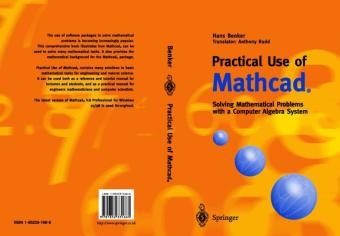Read more
The use of software packages to solve mathematical problems is becoming increasingly popular. This comprehensive book illustrates how Mathcad can be used to solve many mathematical tasks. It also provides the mathematical background for the Mathcad package. Practical Use of Mathcad contains many solutions to basic mathematical tasks for engineering and natural science. It can be used both as a reference and tutorial manual for lecturers and students, and as a practical manual for engineers mathematicians and computer scientists. The latest version of Mathcad V.8 Professional for Windows 95/98 is used throughout.
List of contents
Preface.- Structure and Operation of Computer Algebra Systems.- Use of Computer Algebra Systems.- Development of Mathcad.- Mathcad in Comparison with other Systems.- Installation of Mathcad.- Program Installation.- Mathcad Files.- Help System.- AXUM.- Mathcad User Interface.- Menubar.- Symbolbar.- Formatbar.- Calculation Palette.- Worksheet.- Messagebar.- Mathcad Worksheet.- Text Layout.- Layout of Calculations.- Management of Worksheets.- Electronic books.- Properties, Structure and Use.- Provided Books, Extension Packets and Libraries.- Exact and Numeric Calculations.- Exact Calculations Using Computer Algebra.- Numeric Calculations.- Control of Calculations.- Error Messages.- Numbers.- Real Numbers.- Complex Numbers.- Integrated Constants.- Variables.- Built-in Variables.- Simple and Indexed Variables.- Range Variables.- Character Strings.- Data Management.- Data Input.- Data Output.- Data Exchange.- Programming.- Comparison Operators and Logical Operators.- Definition of Operators.- Assignments.- Branches.- Loops.- Create Simple Programs.- Dimensions and Measurement Units.- Basic Arithmetic Operations.- Transformation of Expressions.- Introduction.- Simplification.- Partial Fraction Factorization.- Raise to Power.- Multiplication.- Factorization.- Reduce to a Common Denominator.- Substitution.- Transformation of Trigonometric Expressions.- Sums and Products.- Vectors and Matrices.- Input.- Vector and Matrix Functions.- Computational Operations.- Determinants.- Eigenvalues and Eigenvectors.- Equations and Inequalities.- Systems of Linear Equations and Analytical Geometry.- Polynomials.- Nonlinear Equations.- Numeric Solution Methods.- Inequalities.- Functions.- General Functions.- Mathematical Functions.- Graphics.- Curves.- Surfaces.- Point Graphs.- Diagrams.- Animations.- Import and Export of Graphs.- Differentiation.- Calculation of Derivatives.- Taylor Expansion.- Error Calculation.- Calculation of Boundary Values.- Curve Discussion.- Integration.- Indeterminate Integrals.- Determinate Integrals.- Improper Integrals.- Numeric Methods.- Multiple Integrals.- Series.- Numeric Series and Products.- Power Series.- Fourier Series.- Vector Analysis.- Arrays and Their Graphical Display.- Gradient, Rotation and Divergence.- Cure and Surface Integrals.- Differential Equations.- Common Differential Equations.- Partial Differential Equations.- Transformations.- Laplace Transformation.- Fourier Transformation.- z-Transformation.- Wavelet Transformation.- Solution of Differences and Differential Equations.- Optimization Tasks.- Extreme Values.- Linear Optimization.- Nonlinear Optimization.- Numeric Algorithms.- Probability.- Combinations.- Probability and Random Numbers.- Expected Value and Deviation.- Distribution Functions.- Random Numbers,- Statistics.- Statistical Measures.- Correlation and Regression.- Simulations.- Electronic Books for Statistics.- Summary.- Bibliography.- Index.
About the author
Prof. Dr. Hans Benker ist am Fachbereich "Mathematik und Informatik" der Martin-Luther-Universität in Halle tätig und hält u. a. Vorlesungen zur Anwendung von Computern bei der Lösung mathematischer Aufgaben.

